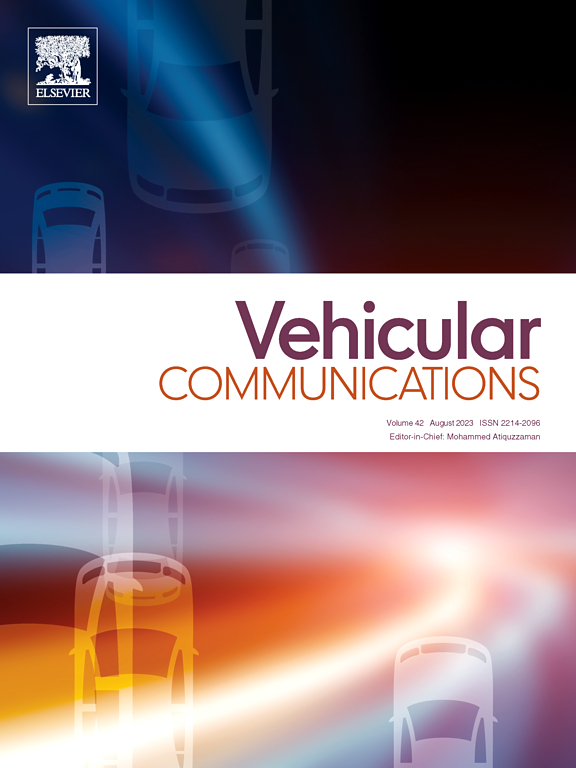Perceptual data importance and freshness aware transmission in millimeter wave vehicular networks
IF 6.5
2区 计算机科学
Q1 TELECOMMUNICATIONS
引用次数: 0
Abstract
The extensive sharing of perceptual data between vehicles and between vehicles and roads has significantly enhanced the performance of intelligent transportation system (ITS). The current vehicular networks using sub-6 GHz struggle to meet the demands for high-rate, low-latency, and highly reliable communication. To address this issue, this paper proposes a perceptual data sharing strategy based on millimeter-wave (mmWave) communication technology. This strategy takes into account the characteristics of vehicular perceptual data, i.e., the importance and freshness of the data, and constructs a mixed-integer nonlinear sum-of-ratios optimization problem. To meet the stringent real-time decision-making requirements of vehicular networks, we leverage the transmission slot characteristics of the Time Division Multiple Access (TDMA) Medium Access Control (MAC) architecture to transform the nonlinear original problem into a series of approximate integer linear programming (ILP) problems. Then we employ maximum weight matching in graph theory to further reduce computational complexity, enabling the problem to be solved in polynomial time. Additionally, we have designed a brute-force algorithm to ensure the global optimum is achieved, thereby validating the performance of our proposed algorithm. Comparative simulation studies with the brute-force algorithm, the ILP solver, the edge coloring algorithm, our previously developed parameterization-based iterative algorithm (PIA), and the First-Come-First-Serve (FCFS) scheduling scheme verify the effectiveness of our proposed algorithm.
毫米波车载网络中感知数据重要性和新鲜度感知传输
车辆之间以及车辆与道路之间的感知数据广泛共享,极大地提高了智能交通系统的性能。目前使用sub- 6ghz的车载网络难以满足高速率、低延迟和高可靠的通信需求。为了解决这一问题,本文提出了一种基于毫米波通信技术的感知数据共享策略。该策略考虑了车辆感知数据的重要性和新鲜度等特点,构建了一个混合整数非线性比例和优化问题。为了满足车载网络严格的实时决策要求,我们利用时分多址(TDMA)介质访问控制(MAC)架构的传输时隙特性,将非线性原始问题转化为一系列近似整数线性规划(ILP)问题。然后利用图论中的最大权值匹配进一步降低计算复杂度,使问题在多项式时间内得到解决。此外,我们还设计了一个蛮力算法来确保实现全局最优,从而验证了我们提出的算法的性能。通过与暴力破解算法、ILP求解器、边缘着色算法、我们之前开发的基于参数化的迭代算法(PIA)和先到先服务(FCFS)调度方案的对比仿真研究,验证了我们提出的算法的有效性。
本文章由计算机程序翻译,如有差异,请以英文原文为准。
求助全文
约1分钟内获得全文
求助全文
来源期刊

Vehicular Communications
Engineering-Electrical and Electronic Engineering
CiteScore
12.70
自引率
10.40%
发文量
88
审稿时长
62 days
期刊介绍:
Vehicular communications is a growing area of communications between vehicles and including roadside communication infrastructure. Advances in wireless communications are making possible sharing of information through real time communications between vehicles and infrastructure. This has led to applications to increase safety of vehicles and communication between passengers and the Internet. Standardization efforts on vehicular communication are also underway to make vehicular transportation safer, greener and easier.
The aim of the journal is to publish high quality peer–reviewed papers in the area of vehicular communications. The scope encompasses all types of communications involving vehicles, including vehicle–to–vehicle and vehicle–to–infrastructure. The scope includes (but not limited to) the following topics related to vehicular communications:
Vehicle to vehicle and vehicle to infrastructure communications
Channel modelling, modulating and coding
Congestion Control and scalability issues
Protocol design, testing and verification
Routing in vehicular networks
Security issues and countermeasures
Deployment and field testing
Reducing energy consumption and enhancing safety of vehicles
Wireless in–car networks
Data collection and dissemination methods
Mobility and handover issues
Safety and driver assistance applications
UAV
Underwater communications
Autonomous cooperative driving
Social networks
Internet of vehicles
Standardization of protocols.
 求助内容:
求助内容: 应助结果提醒方式:
应助结果提醒方式:


